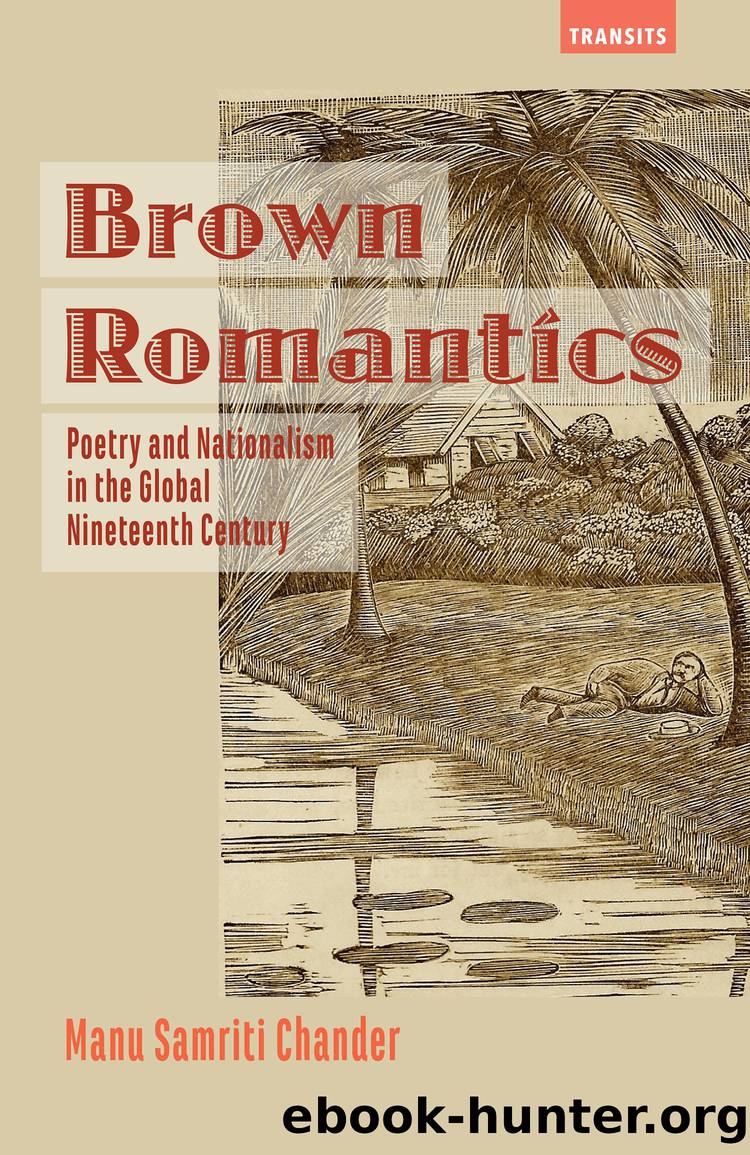Brown Romantics by Chander Manu Samriti;

Author:Chander, Manu Samriti; [Chander, Manu Samriti]
Language: eng
Format: epub
Publisher: Bucknell University Press
Published: 2017-05-19T00:00:00+00:00
Figure 2.2. Charles Stephens, The River, 1886. Courtesy of the Moorland-Spingarn Research Center, Howard University.
I would suggest that the secular standard of taste to which Martin appeals here reinforces the gap between sites of literary dominance and those peripheral and colonial. Martin is acceptable to the international literary market as a kind of native informant, a privileged interpreter whose scope is restricted to the local. If a poem such as âThe Negro Villageâ describes the pagan Afro-Creole population of Guiana for the good of Guianese Christians, a poem such as âA Shaded Spotâ describes Guiana for the good of a stable geographical epistemology in which Guiana is figured as âuntutored,â âquaint,â and âprimitive.â Guiana is the negro village in a global world order, and the potential to critique normative taste in the nineteenth century is lost in Martinâs turn away from the religious.
At the same time, it should be noted that Martinâs strategy would inform a later generation of Guyanese poets who would go on to mobilize the fetishization of the tropics against colonial sensibilities in order to articulate a postcolonial national identity.67 In order to understand this legacy, we need to see how Martin subtly critiques the idea that Guiana is a knowable space, made available to the world by the local poet. The final line of âA Shaded Spotâ settles in âthe border-land between knowing and unknowing,â challenging our capacity to âknowâ geographic space and thus confounding colonial epistemology. The line hints that any truth gleaned from the poem about the local is at best partial. Rather than restrict the ways in which the audience can interpret Guiana, Martin opens up the space as one of indeterminacy. This theme is suggested rhythmically, as well, as we move from consistent masculine rhymes to, finally, a trio of feminine rhymes, and from the certainty of steady iambicsâpunctuated with but not disrupted by occasional substitutionsâto the anomalous string of dactyls in the last line, interrupted with a medial iamb. Formally as well as thematically, the poem closes by refusing to meet the expectations of an English or American readership.
The challenge posed to the colonial desire to know its others would be reiterated a century later by (to name but one example) the Guyanese poet John Agard, whose âPalm Tree Kingâ presents a sly and wry native informant, the titular âpalm tree kingâ:
Because I come from the West Indies
certain people in England seem to think
I is a expert on palm trees
So not wanting to sever dis link
with me native roots (know what ah mean?)
or to disappoint dese culturer vulture
I does smile cool as seabreeze
and say to dem
which specimen
you interested in
cause you talking
to the right man
I is palm tree king
I know palm tree history
like de palm o me hand68
The poem goes on challenge the touristâs quest for local knowledge, finally turning the tables and refiguring the palm treeâsynecdoche for Guyanaâas a riddle for the tourist/reader to solve, and warning him, âFind the solution / and you get a revolution.â69 The form
Download
This site does not store any files on its server. We only index and link to content provided by other sites. Please contact the content providers to delete copyright contents if any and email us, we'll remove relevant links or contents immediately.
The Power of Myth by Joseph Campbell & Bill Moyers(681)
Four Shakespearean Period Pieces by Margreta de Grazia(666)
A Social History of the Media by Peter Burke & Peter Burke(640)
Inseparable by Emma Donoghue(610)
The Complete Correspondence 1928-1940 by Theodor W. Adorno & Walter Benjamin(510)
Bodies from the Library 3 by Tony Medawar(487)
The Spike by Mark Humphries;(470)
Culture by Terry Eagleton(465)
A Theory of Narrative Drawing by Simon Grennan(461)
World Philology by(452)
Ideology by Eagleton Terry;(445)
Farnsworth's Classical English Rhetoric by Ward Farnsworth(444)
A Reader’s Companion to J. D. Salinger’s The Catcher in the Rye by Peter Beidler(432)
Adam Smith by Jonathan Conlin(425)
Comic Genius: Portraits of Funny People by(410)
Monkey King by Wu Cheng'en(403)
Game of Thrones and Philosophy by William Irwin(400)
High Albania by M. Edith Durham(399)
Early Departures by Justin A. Reynolds(383)
